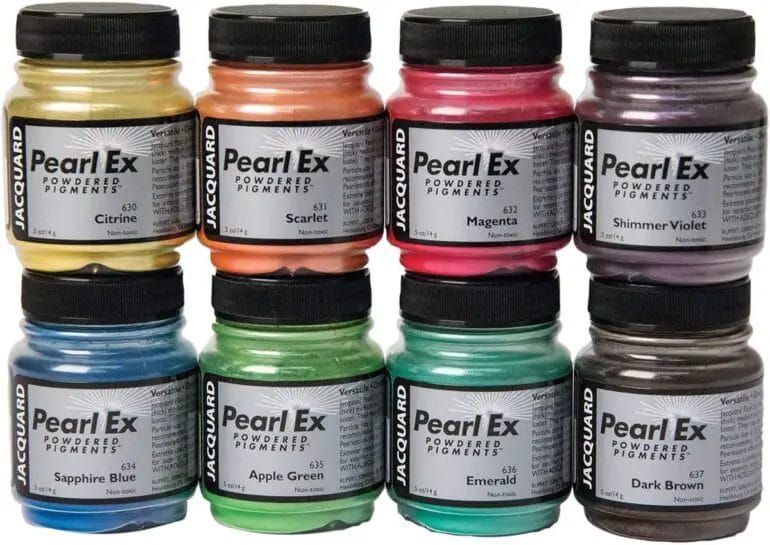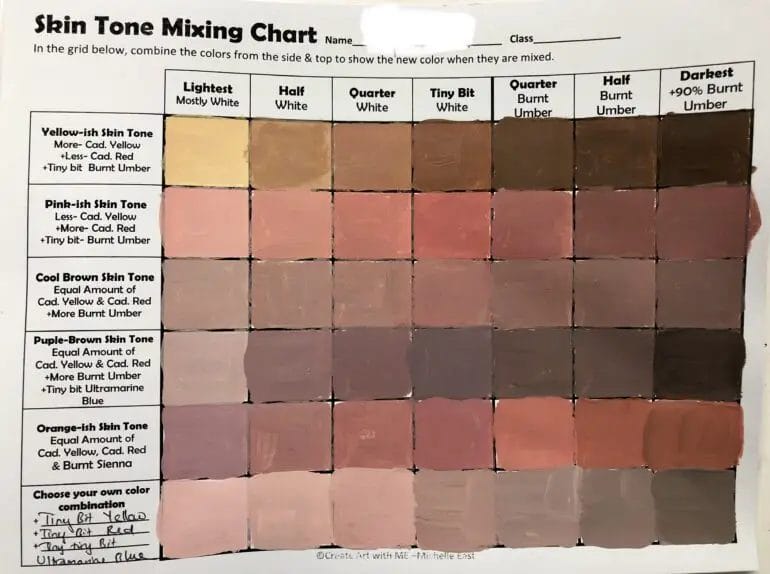Looking to take your acrylic painting to the next level? Learn how to expertly mix pigment into acrylic paint for vibrant and customized colors that will make your artwork pop.
By understanding the fundamentals of color theory and mastering the art of pigment mixing, you can create an endless range of hues, shades, and tints, allowing for endless creative possibilities.
In this guide, we’ll walk you through the step-by-step process of mixing pigments into acrylic paint, including choosing the right pigments, measuring ratios, and achieving consistent and smooth results.
Whether you’re a beginner or a seasoned artist, this skill will enhance your painting technique and help you achieve the desired color intensity and harmony.
Get ready to unleash your creativity and bring your paintings to life with beautifully blended and personalized colors!

Proper Techniques for Mixing Pigments into Acrylic Paint
Acrylic paint is a versatile and popular medium used by artists of all levels. One of the key skills every artist should master is the proper technique for mixing pigments into acrylic paint. Whether you are a beginner or an experienced artist, understanding how to mix colors can greatly enhance your artwork and allow you to create a wide range of hues and shades. In this section, we will explore the proper techniques for mixing pigments into acrylic paint.
1. Gather Your Materials
Before you begin mixing pigments, it’s important to gather all the necessary materials. Here’s what you’ll need:
- Acrylic paint – choose a variety of colors that you want to mix.
- Palette – a flat surface where you can mix your paints.
- Paintbrushes – have a selection of different brush sizes to apply and mix the paint.
- Water – for thinning the paint if needed.
- Palette knife – for mixing the pigments.
2. Start with a Clean Palette
Ensure that your palette is clean and free from any remnants of previous paint mixing. This will prevent any unwanted color contamination.
3. Squeeze Out the Paint
Squeeze out a small amount of each color you plan to mix onto your palette. Start with a small amount as you can always add more if needed.
4. Mix the Colors
Use a palette knife to mix the pigments together. Start by picking up a small amount of one color and place it next to another color on the palette. Use a back and forth scraping motion to blend the colors together. Gradually add more of each color until you achieve the desired hue.
Remember to clean your palette knife between each color to avoid muddying the colors.
5. Test the Color
Once you have mixed the colors together, it’s important to test the hue on a separate piece of paper or canvas. This will allow you to see how the color appears when dry and make any necessary adjustments.
6. Adjust the Consistency
If the paint is too thick, you can add a small amount of water to thin it out. Be sure to add water incrementally to avoid making the paint too runny. Conversely, if the paint is too thin, you can add more pigment to achieve a thicker consistency.
7. Clean Up
After you have finished mixing your pigments, be sure to clean your palette, brushes, and palette knife thoroughly. This will prevent the paint from drying and make it easier to use in your next painting session.
8. Practice and Experiment
Mixing pigments into acrylic paint is a skill that takes practice. Don’t be afraid to experiment with different color combinations and techniques. The more you practice, the better you will become at creating unique and vibrant colors.
In summary, mastering the technique of mixing pigments into acrylic paint can greatly enhance your artwork. By following the proper techniques, gathering the necessary materials, and allowing yourself to experiment, you can create a wide range of colors and achieve the desired hue and consistency. Happy painting!

Achieving the Desired Color with Pigment Mixing in Acrylic Paint
When it comes to painting with acrylics, one of the most important aspects is achieving the desired color. Whether you are a beginner or an experienced artist, understanding how to mix pigments to create the color you want is essential. In this section, we will explore the process of pigment mixing in acrylic paint and provide some tips and techniques to help you achieve the perfect hue.
Understanding Color Theory
Before diving into the process of pigment mixing, it is important to have a basic understanding of color theory. Color theory refers to the principles and guidelines that govern how colors interact with each other. It helps artists create harmonious and visually appealing compositions.
Colors are typically categorized into primary, secondary, and tertiary colors. Primary colors, such as red, blue, and yellow, are the building blocks of all other colors. Secondary colors, like orange, green, and purple, are created by mixing two primary colors. Tertiary colors are formed by mixing a primary color with a secondary color.
Additionally, color theory introduces the concepts of hue, value, and saturation. Hue refers to the actual color, value represents the lightness or darkness of a color, and saturation determines the intensity or purity of a color.
Choosing the Right Pigments
When it comes to pigment mixing, the choice of pigments plays a crucial role in achieving the desired color. Acrylic paints come in a wide range of pigments, each with its own unique characteristics. It is essential to understand the properties of pigments and how they interact with each other.
Professional artists often use a limited palette of primary colors, such as cadmium red, cobalt blue, and cadmium yellow, to achieve a wide range of colors. By starting with these primary colors, you can mix them together to create secondary and tertiary colors.
It is also important to consider the opacity or transparency of the pigments you choose. Some pigments are more opaque, meaning they cover the underlying layers well, while others are more transparent, allowing the layers underneath to show through. Understanding the opacity of pigments will help you achieve the desired level of coverage in your painting.
Basic Pigment Mixing Techniques
Once you have chosen your pigments, it’s time to start mixing them to achieve the desired color. Here are some basic pigment mixing techniques:
- Gradual Mixing: Start by placing small amounts of the primary colors you want to mix onto your palette. Use a palette knife or brush to gradually mix the colors together, adding more of each color as needed. This technique allows you to create variations of the desired color.
- Color Mixing Chart: Create a color mixing chart by mixing different ratios of your chosen primary colors. This chart will serve as a visual reference for future color mixing. You can use a grid to organize the colors and label each square with the corresponding color ratio.
- Layering: Acrylic paint dries quickly, allowing you to layer colors on top of each other. This technique involves applying multiple layers of different colors to achieve the desired hue. Start with a base color and gradually layer other colors on top to create depth and richness.
Experimenting and Practice
Color mixing in acrylic paint is a skill that improves with practice and experimentation. Don’t be afraid to explore and try different combinations of pigments to achieve the color you envision. Take note of the ratios and techniques you use for future reference.
Remember to keep a clean palette and brushes when mixing colors to avoid contamination. Start with small amounts of pigments and mix them gradually to avoid wasting paint.
Summary
Mixing pigments in acrylic paint is an essential skill for any artist. By understanding color theory, choosing the right pigments, and practicing different mixing techniques, you can achieve the desired color in your paintings. Experimentation and practice will further enhance your ability to create vibrant and harmonious compositions. So, grab your acrylic paints and start exploring the world of color mixing!

Creating Different Effects by Mixing Pigments in Acrylic Paint
Acrylic paint is a versatile medium that allows artists to experiment and create various effects by mixing different pigments. By combining colors and manipulating their properties, artists can achieve unique textures, shades, and tones in their artwork. In this section, we will explore some techniques and tips for creating different effects by mixing pigments in acrylic paint.
1. Color Mixing Basics
Before diving into specific techniques, it’s essential to understand the basics of color mixing. Acrylic paints are available in a range of colors, including primary colors (red, blue, and yellow) and secondary colors (orange, green, and purple). By mixing different amounts of these colors, you can create a vast array of hues.
Here are some fundamental principles of color mixing:
- Primary colors can be combined to create secondary colors. For example, mixing equal parts of red and blue creates purple.
- Experiment with different ratios of colors to achieve desired shades. Adding more of one color will result in a more dominant hue.
- Complementary colors, those opposite each other on the color wheel, can create vibrant and contrasting effects when mixed.
2. Creating Tints and Shades
Tints and shades refer to variations of a color created by adding white or black. These techniques can add depth and dimension to your artwork.
To create a tint, simply mix a small amount of white paint with your desired color. Gradually add more white until you achieve the desired level of lightness. Tints can be used to create soft, pastel-like effects in your artwork.
On the other hand, shades are created by adding black paint to a color. Start with a small amount of black and gradually mix it into your chosen pigment. Shades can add depth and intensity to your artwork, creating a more dramatic effect.
3. Glazing and Layering
Glazing and layering are techniques that involve applying translucent layers of paint to achieve different effects. These techniques are often used in creating smooth gradients, enhancing depth, or adding a glossy finish to a painting.
Glazing involves thinning down the paint with a medium (such as glazing medium or water) and applying it in transparent or semi-transparent layers over a dry base color. This technique allows light to pass through the layers, creating a luminous effect.
Layering, on the other hand, involves applying multiple layers of paint on top of each other, allowing each layer to dry before adding the next. This technique can create depth and dimension in your artwork, as well as subtle variations in color.
4. Creating Texture with Impasto
Impasto is a technique where thick layers of paint are applied to create texture and dimension in a painting. This technique is especially effective in creating expressive and tactile effects.
To achieve impasto, mix acrylic paint with a thickening medium or use heavy-bodied acrylics straight from the tube. Apply the paint with a palette knife or a brush, creating visible brush strokes and texture on the canvas.
Experiment with different pressures and angles to create varying levels of impasto. This technique can add a three-dimensional quality to your artwork and make it visually engaging.
5. Blending and Wet-on-Wet Techniques
Blending and wet-on-wet techniques involve mixing colors directly on the canvas to achieve smooth transitions and gradients.
In blending, apply two or more colors side by side and use a brush or a blending tool to mix them together. This technique is useful for creating smooth transitions between colors or blending shadows and highlights.
Wet-on-wet technique involves applying fresh paint onto a wet base layer. This technique allows the colors to blend and interact, creating soft and blended effects. It is essential to work quickly with this technique before the paint dries.
In Summary
By exploring the various techniques and principles of color mixing in acrylic paint, artists can unlock endless possibilities for creating different effects in their artwork. Whether it’s experimenting with tints and shades, glazing and layering, impasto, or blending techniques, each method offers a unique way to express creativity and achieve desired textures and tones.
Remember, the key is to experiment, practice, and have fun with mixing pigments in acrylic paint. The more you explore and push the boundaries, the more you will discover the incredible versatility and potential of this medium.
Tips and Tricks for Successful Pigment Mixing in Acrylic Paint
The process of mixing pigments in acrylic paint can sometimes be challenging, especially for beginners. However, with the right techniques and a bit of practice, you can achieve beautiful and vibrant colors in your artwork. In this section, we will discuss some tips and tricks that will help you master the art of pigment mixing in acrylic paint.
1. Use a Neutral Background
Before you start mixing pigments, it is advisable to use a neutral background color. This will provide a true reference point for evaluating your mixed colors. A white or gray background works best, as it allows you to see the true intensity and hue of the colors you are creating.
2. Start with Primary Colors
When mixing pigments, it is always a good idea to start with the primary colors – red, blue, and yellow. These colors cannot be created by mixing other colors together and form the basis of all other colors. By starting with primary colors, you can easily create a wide range of secondary and tertiary colors.
3. Use a Palette Knife
A palette knife is a handy tool when it comes to mixing pigments in acrylic paint. It allows for precise mixing and helps in achieving a smooth and consistent color. Use the palette knife to scrape the pigments together, gradually incorporating the colors until you achieve the desired hue.
4. Control the Intensity with White and Black
If you want to control the intensity of a color you are mixing, use white or black paint. Adding white to a color will create a lighter and more pastel shade, while adding black will darken the color. By carefully adding small amounts of white or black, you can achieve subtle variations in color intensity.
5. Test the Colors
Always test the colors you have mixed before applying them to your artwork. Apply a small amount of the mixed color onto a piece of paper or canvas to see how it looks. This will help you avoid any surprises when working on your actual piece.
6. Mix Colors in Small Amounts
When mixing pigments, it is better to start with small amounts of paint. This gives you better control over the color mixing process and allows for adjustments if needed. It is easier to add more paint to lighten a color than to darken it.
7. Keep a Record of Your Mixes
To recreate a specific color in the future, it is helpful to keep a record of the pigments you used and the ratios you mixed. This will save you time and effort in the long run, especially if you frequently work with certain color palettes.
8. Experiment and Have Fun
One of the most important things in pigment mixing is to experiment and have fun. Don’t be afraid to try different combinations and explore new color possibilities. Mixing pigments is a creative process, and the more you practice, the better you will become at achieving the desired colors in your artwork.
In summary, successful pigment mixing in acrylic paint requires practice, patience, and an understanding of color theory. By following these tips and tricks, you can enhance your skills and create stunning colors in your artwork. So, grab your palette knife and start experimenting with pigments to unleash your creativity!
FAQs
How do I mix pigment into acrylic paint?
To mix pigment into acrylic paint, start by squeezing out a small amount of acrylic paint onto a palette. Then, gradually add a small amount of pigment powder and mix it thoroughly with a palette knife or brush. Keep adding small amounts of pigment until you achieve the desired color intensity. Remember to mix well to ensure the pigment is evenly distributed throughout the paint.
Conclusion
In conclusion, learning how to mix pigment into acrylic paint can greatly enhance your artistic abilities. By following the right techniques, you can achieve vibrant and unique colors that bring your paintings to life. Remember to start with a small amount of pigment and gradually add it to your paint to control the intensity. Experimenting with different ratios and combinations will allow you to create endless possibilities and customize your palette to suit your artistic vision.
So, whether you’re a beginner or an experienced artist, don’t be afraid to dive into the world of pigment mixing. Embrace the versatility of acrylic paint and let your creativity flow!
